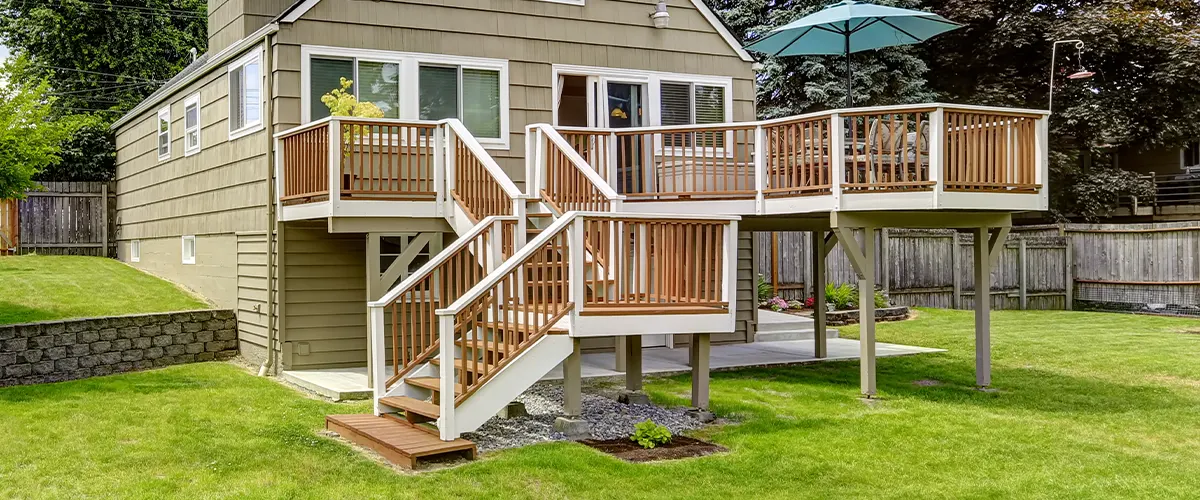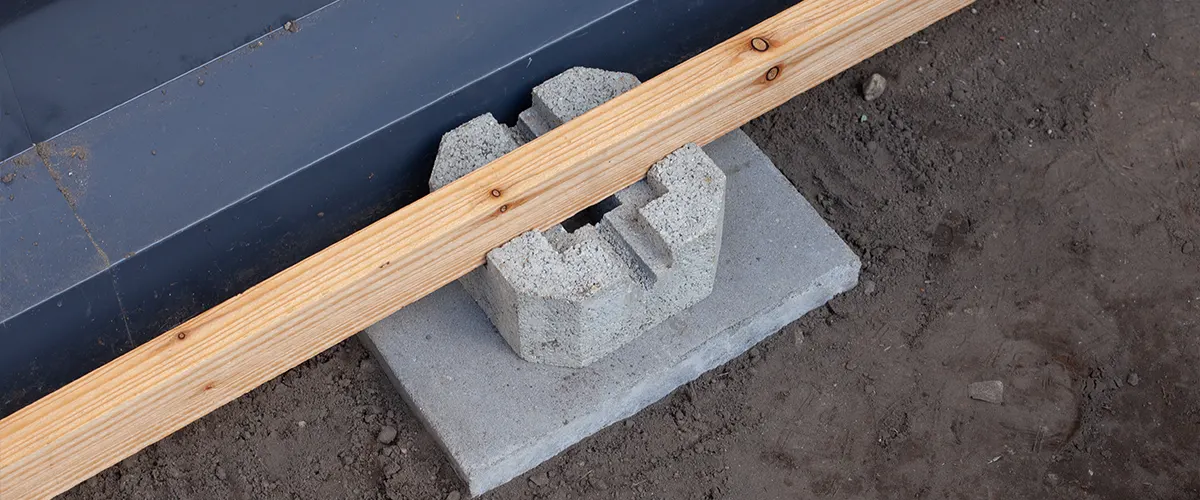When it comes to building decks, the most important aspect needs to be their safety.
Deck footings are what keep your deck safe and secure, and the stronger they are, the more confident and stress-free you’ll feel on your deck.
In this guide, we’ll dive deeper into what types of deck footings there are, and what to consider when choosing them.
Let’s begin.

What Are Deck Footings?
Before we move on, it’s important to discuss the difference between live load and dead load.
- Live load is the weight of people, furniture, and any other thing on your deck.
- Dead load is the weight of the deck itself, with all the materials, hardware, railing, stairs etc.
Deck footings are an essential element of any deck building project, as these ensure your deck will sustain both dead and live load.
Especially for elevated decks, you want to ensure sturdy and resistant footings, as you don’t want to risk seeing your deck collapsing under your feet.
What Are Deck Footings?
Back in the old days, the frame posts used to be placed directly in the ground. This meant the lumber was prone to damage from insects, humidity, and water, leading to rot.
Today, there are different kinds of footings, each with a better functionality than the other.
In most cases, deck footings are concrete footings in the form of a pad, of either 2-feet square or 2-feet in diameter, poured directly into the ground.
While the normal thickness of concrete deck footings is somewhere around 8 inches, professional deck builders will determine if your deck will need more.
Note: The footing holes of solid concrete footing need to be installed below the frost line. When water freezes, it expands and can cause your deck to move from its initial place. This moving can result in a structural hazard very quickly.
Depending on the soil on your property, there are 4 types of deck footings that professional deck builders use.

The 4 Types Of Deck Footings
Below you’ll find the most common types of deck footings that deck builders use to secure any deck.
- Buried post and footing
- Tube Pier
- Bell Pier
- Pier and footing
Each of these will have different advantages and different prices too. Let’s discuss each of them.
1. Buried Post And Footing
Although this type of footing is more affordable than the others, it’s one of the least reliable footing options.
It requires an excavation of between 8 to 10 inches and poured concrete at the base. You’ll install the wood post and place it on the concrete pad, but then you’ll bury it in the ground.
As we mentioned earlier, burying your post in the ground means the wood will be susceptible to insects and water, leading to the most serious cause of concern – rot.
Rot will weaken the post and will cause serious damage to your deck. Which is why this type of footing is so inexpensive. You’ll pay between $25 to $36 per footing, for materials.
2. The Tube Pier
A tube pier footing is one of the easiest footings to install. It consists of a tube buried in the ground and filled with concrete.
As with any footing, it needs to be placed below the frost line. We even recommend digging an extra 4 inches deep to be safe.
Note: The tube footing diameter has to be exactly the same all around the footing. Tube footing relies on the friction and pressure of the soil that needs to be equal from all sides.
For a 12″ diameter concrete footing, you’ll spend between $200 to $400, depending on the concrete and tube material.
3. Bell Pier
A bell pier has the shape of a bell. The deeper the pier goes in the ground, the larger the diameter will be.
A larger concrete base will allow a better distribution of the live and dead load into the footing, and from there in the ground. It has a much better stability than the other footings mentioned above, but it requires more concrete material, therefore it’s more expensive.
4. Pier & Footing
The pier and footing is a very common footing used by both professionals and DIYers. Although it requires more work, this is a fairly easy and reliable footing.
The actual footing is poured in the ground first and leveled. Then, the first pier can be poured onto the footing.
For this, you’ll require some professional tools, like a template for the concrete post.

Things To Consider Before Installing Your Deck Footings
Before you decide on the type of footings that you want, there’s some other things to consider when installing your deck footings.
Although your local professionals from Deck Bros will take care of these things for you, it doesn’t hurt to know in advance what needs to be taken care of.
Things To Consider Before Installing Your Deck Footings
The frost line is where the soil begins freezing. You’ll want to avoid constant expansions and contractions of the wood, as it will cause it to loosen up and damage its integrity.
In Omaha, Nebraska, the frost line is 48 inches.
Depending on the concrete mix you’re using, the concrete can also contract and expands, causing it to break. In deck construction, a concrete deck footing and concrete deck posts need to be reliable and not change its composition.
The Size And Layout Of Your Deck Footings
Size and layout are two extremely important aspects you’ll need to consider before deciding on what deck footings you’ll want.
- The footings' size will determine how much weight your entire structure can sustain. If you have a larger deck than usual, you'll want your footings, posts, and frame to be reliable and strong enough to sustain the entire weight.
- The Layout will determine the ideal places to install the footings. It's important to have the right layout because you'll want every part of your new deck to be ensured with at least a post.
Outdoor spaces, like decks and other permanent structures, require a lot of knowledge of the local building codes and regulations.
At Deck Bros, we take care of the building permit for you, and you won’t have to worry about your deck design, deck framing, or deck hardware. We’ll make sure your deck is up to the highest standards, and the local building department inspections are successful.
Ensure You're Not Damaging Underground Pipes Or Cables
The problem with pipes and cables underground is everlasting for every project where you have to dig.
You want to ensure you won’t hit anything important while digging. Broken pipes will cause major leaks that are difficult and expensive to repair.
Moreover, sometimes you might provoke a leak and you’ll only realize it after weeks, when your water bill will be outrageously hefty.
And there’s the same issue with cables. Not having power for weeks and waiting for your provider to come fix everything is a nightmare no one should have to go through.
Conclusion
So, what deck footings are right for you?
Based on the different types of deck footings we mentioned above, the Bell Pier and Pier and Footing options are probably your best bet if you want something safe and reliable. But to pour concrete footings, there are many other factors that professionals take into consideration.
It’s up to you to decide how much you want to invest in your deck’s safety, but if you need professional advice, we’re here for you.
You can request a quote and we’ll get in touch within a day, or you can call us directly at (402) 369-5724 to discuss your upcoming project.

